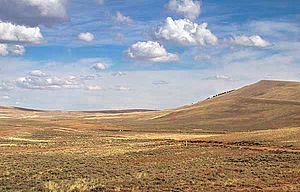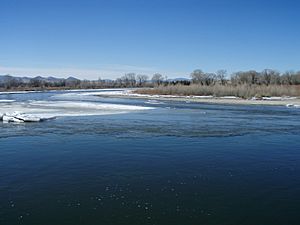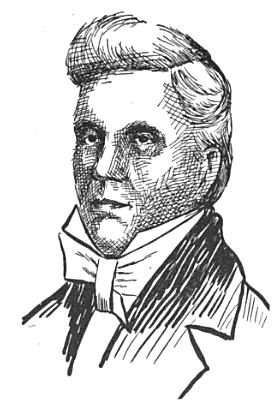Missouri Fur Company facts for kids
| Private | |
| Industry | Fur trade |
| Fate | Dissolved |
| Successor | None |
| Founded | St. Louis, Missouri, U.S. (February 24, 1809) |
| Founder | Manuel Lisa, Jean Pierre Chouteau, William Clark |
| Defunct | June 1, 1830 |
| Headquarters |
St. Louis, Missouri
|
|
Area served
|
Louisiana Territory |
The Missouri Fur Company was one of the first fur trading companies in St. Louis, Missouri. It was also known as the St. Louis Missouri Fur Company or the Manuel Lisa Trading Company. This company was started by a group of fur traders and business people from St. Louis and Kaskaskia, Illinois. Important founders included Manuel Lisa and members of the Chouteau family.
The company explored the upper Missouri River and traded with many different Native American tribes. It was a model for other fur trading companies along the Missouri River until the 1820s. The company was closed and restarted several times. It operated under different names from 1809 until it finally closed in 1830.
Contents
Starting the Company
When the Lewis and Clark expedition returned to St. Louis in 1806, they told exciting stories about the rich lands along the upper Missouri River. They reported that there were many beavers there. At this time, beaver hats were very popular, so there was a high demand for fur.
Manuel Lisa, a trader who had recently arrived in St. Louis, heard these reports. He decided to go on his first fur-trading trip to the upper Missouri. He worked with Pierre Menard and hired some people who had been with Lewis and Clark. These included the famous trapper and guide John Colter and George Drouillard. They started their journey in 1807. They built Fort Raymond where the Bighorn and Yellowstone rivers meet in what is now Montana.
When Lisa returned to St. Louis in August 1808, he told other merchants about the great potential for fur trading in that area.
On February 24, 1809, Lisa and other important fur traders from St. Louis formed a company. Some of the members included Jean Pierre Chouteau (whose father helped start St. Louis), William Clark (who led the Lewis and Clark Expedition), and Andrew Henry.
The company's rules were signed on March 9, 1809. They said that Lisa would be a field trader, and Clark would be the agent in St. Louis. The company bought the equipment and trading posts from its members' private fur businesses, including Fort Raymond. They had about $40,000 worth of resources. They planned to trade items like guns and ammunition with Native Americans for furs. The new Missouri Fur Company planned to operate in the entire Missouri River valley, north of the Platte River.
Company Trips and Changes
Henry-Menard Expedition (1809–1811)
The new Missouri Fur Company gathered enough money to send 350 men to trap beaver near the start of the Missouri River. They also planned to trade with Native American tribes. The governor of Missouri Territory, Merriwether Lewis, also hired the company. He wanted them to take Mandan Chief Shehaka back to his people. The chief had traveled with Lewis and Clark to meet President Thomas Jefferson in Washington City. On his way back, he was stopped by an Arikara attack. Governor Lewis paid the Missouri Fur Company $10,000 to safely return Chief Shehaka to Fort Mandan.
So, two groups set out in the spring of 1809 and traveled up the Missouri River to Fort Mandan. Manuel Lisa and Pierre Chouteau returned to St. Louis after Chief Shehaka was back with his people. They left the rest of the group with Pierre Menard and Andrew Henry. This group moved all the boats and supplies upriver to Fort Raymond, where they spent the winter.
Menard knew there would be dangers. He wrote to a friend, "It is said that one cannot imagine the quantity of beaver that there is, but there is the difficulty of the savage Black Feet who plunder often." Besides the danger from the Blackfeet, there were also disagreements within the company. Some American members felt that the leaders favored the French members.
Despite these problems, Menard, Andrew Henry, and 32 other men headed for the headwaters of the Missouri in March 1810. John Colter, who had escaped the Blackfeet twice before, guided them. The large group made him feel safe enough to lead them to the Three Forks of the Missouri. They arrived on April 3 and began building a trading post.
The group was trapping many beavers and expected to make a good profit. However, they had built their post on Blackfeet land without permission. The Blackfeet did not allow trapping on their land. Also, the Blackfeet were angry because Lisa had traded with the Crow Nation, who were their enemies.
On April 12, 1810, a group of Blackfeet warriors attacked the traders. They killed five men and took horses, guns, ammunition, traps, and furs. They attacked again on April 23, 1810. After this, some traders, including Pierre Menard, decided to return to St. Louis. Andrew Henry stayed in charge of the remaining trappers. During Menard's return trip, George Drouillard, a former interpreter for Lewis and Clark, was killed in an ambush in May 1810.
Later, the trappers under Henry's command at the Three Forks post were attacked by more than 200 Blackfeet warriors. They were forced to leave the post in late 1810.
Henry and his trappers moved across the Continental Divide to a temporary trading post. This was on the north fork of the Snake River, now called Henry's Fork in Idaho. When they couldn't find enough food, they had to kill their horses to eat. In the spring of 1811, the group broke up. Some went south towards Spanish territory, and others, like Andrew Henry, went east back to St. Louis. This first major trip by the Missouri Fur Company did not bring in many furs and led to them leaving Fort Lisa on the Yellowstone River.
Chouteau Expedition (1810)
While the Henry-Menard Expedition faced difficulties, Auguste Pierre Chouteau led his own trip to the Mandan people. He lost many furs and a trading post when a fire destroyed the post. These losses caused Chouteau to return to St. Louis in late 1810. The prices for beaver furs were also low, making his expedition a financial failure.
Company Changes in 1812 and 1813
The company's first agreement was supposed to end in March 1812. However, the leaders closed and restarted the company in January 1812. The new company had fewer of its original members and was worth about $30,000. It became a joint-stock company with ten shares. Only owners in St. Louis could buy shares. The rich fur merchant John Jacob Astor offered to invest more money, but the company members said no.
In early 1812, the newly organized company sent a trip with $11,000 worth of trade goods up the Missouri River. Manuel Lisa led this trip. When he returned on September 27, 1812, they had few furs and made little profit. The next year's trip was also not profitable. So, in the fall of 1813, the company was closed and reorganized again.
Manuel Lisa became the main owner of this new company. It had even fewer original members and less money. Around this time, the company started to be called the Manuel Lisa Trading Company. Because the War of 1812 had started, Lisa did not do many trading operations. News of the war reached the Louisiana Territory in 1813. The war stopped trade with the upper Missouri River tribes until 1816. During this time, the company focused its efforts near Council Bluff. A new Fort Lisa was built there, in what is now North Omaha, Nebraska.
Company Changes in 1819
After the war, in 1819, the company closed and was reorganized again. Only Lisa remained from the first members. Other people bought the remaining shares. Lisa's last trip left in late 1819 and returned from Fort Lisa in the spring of 1820. After he returned, Lisa sadly died in St. Louis in August 1820 from an unknown illness.
Joshua Pilcher became the new president of the company. In 1821, he tried to expand operations to the upper Missouri region. Pilcher sent a trip to the mouth of the White River. There, in the fall of 1820, the company built Fort Recovery. In late 1821, Pilcher ordered the building of Fort Benton at the mouth of the Bighorn River on the Yellowstone River. This was the same place where the earlier Fort Lisa had been.
Jones' Expedition (1822)
In early 1822, Pilcher sent a trip led by Robert Jones from St. Charles, Missouri to the new Fort Benton. By the end of the year, this group had brought back over $25,000 worth of furs to St. Louis. In early 1823, the same group left Fort Benton to talk with the Blackfeet about trading. They reached the Three Forks by May. In late May 1823, the group met some Blackfeet and discussed building a new post near the Great Falls of the Missouri.
Even though the Blackfeet treated the Jones Expedition well at first, the expedition decided to go back towards Fort Benton. On May 30, 1823, the same Blackfeet attacked the expedition. Pilcher wrote about the attack:
My mountaineers have been defeated, and the chiefs of the party both slain; the party were attacked by three or four hundred Blackfoot Indians in a position on the Yellowstone River where nothing but defeat could be expected. Jones and Immell and five men were killed. The former, it is said, fought most desperately. <...> I think we lost at least $15,000.
—Joshua Pilcher, Letter to Benjamin O'Fallon, U.S. Agent for Indian Affairs, July 3, 1823.
The people who survived built boats to float down to Fort Vanderburgh on the Missouri River. Eventually, they returned to St. Louis.
Closing Down
After the Jones Expedition, Pilcher closed the Missouri Fur Company in the fall of 1824. A new company, named after Pilcher, was formed to take over the Missouri Fur Company's property. This new company quickly left all the old Missouri Fur Company posts above Council Bluff.
The new company faced challenges. Other companies like the American Fur Company (owned by John Jacob Astor) and the Rocky Mountain Fur Company (owned by former Missouri Fur Company shareholder Andrew Henry) were growing. Competition was not the only problem. The company's suppliers and agents also became less reliable.
Pilcher Expedition (1827–1829)

Pilcher led the last trip for the Pilcher Company. They left Council Bluff in September 1827 and headed towards the Salt Lake Valley. While they were camping in the South Pass, all of the expedition's horses were stolen. The group then camped on the Green River for the winter. During this winter camp, water damaged all of the expedition's trade goods.
In the spring of 1828, most of the men returned to Council Bluff. However, Pilcher and nine others bought new horses. In August 1828, they explored the Pacific Northwest to look for possible trade routes. The group spent the winter at Flathead Lake, but their horses were stolen in February 1829. Seven of the nine trappers decided to go home. Pilcher and one other person tried to reach Fort Colville on the Columbia River. Traders at Fort Colville, which was owned by the Hudson's Bay Company, offered Pilcher a way to return to St. Louis, and he accepted.
Final End
By the time Pilcher returned to St. Louis in June 1830, he had learned about the Hudson's Bay Company's large network of British traders in Canada. He also saw how powerful the American Fur Company had become. By this time, the American Fur Company almost completely controlled the American fur trade.
Pilcher decided not to continue against such strong competition. With no money left, he closed the Pilcher Company. It was not bought by another company. After it closed, most of its former traders went to work for the American Fur Company. This company had its main western office in St. Louis. However, the busiest time for the fur trade had already passed.
See also
 In Spanish: Missouri Fur Company para niños
In Spanish: Missouri Fur Company para niños



